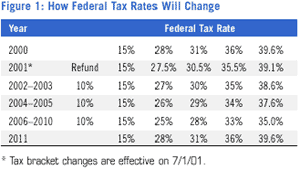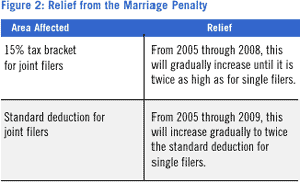| General Tax Changes | |
| Gradual Cuts in Tax Rates | |
Between 2001 and 2006, federal tax rates are scheduled to drop for almost everyone, with the highest income taxpayers realizing the greatest savings. Here are highlights:
|
|

Increase in Child Credit
The child credit, which was $500 per child in 2000, will increase in increments to $1,000 per child by 2010. The full credit is available to joint filers with Adjusted Gross Income (AGI) up to $110,000, single filers or heads of household up to $75,000, and married people filing separately up to $55,000.
Relief for High Income Taxpayers
High-income taxpayers are currently subject to limits on itemized deductions and personal exemptions. In 2001, it is estimated that personal exemptions will be reduced for joint filers at AGI above $199,450, $166,200 for heads of household, and $132,950 for single filers. Itemized deductions will phase out for all filers but those who are married filing separately
above estimated AGI of $132,950. (Source: CCH Incorporated.) Starting in 2006, the impact of these limits will diminish in phases until they are totally repealed in 2010.
Marriage Penalty Relief
The new law offers modest relief from the "marriage penalty," which occurs when two-paycheck couples, filing jointly, pay higher federal taxes than they would owe if they were single. This relief, scheduled to begin in 2005, affects two areas for joint filers: the 15% tax bracket and the standard deduction.

Planning Ideas for General Tax Changes
Reinvest Tax Savings: Starting with 2001 refund checks, get into the habit of making progress toward future goals by reinvesting your tax savings. The new law creates greater opportunity to save and invest with tax advantages.
Defer Income, Accelerate Deductions: As tax rates decline gradually, it can pay to accelerate deductions, defer income, and take advantage of tax-deferred investments. The basic idea is to take any deductions possible before rates decline, while paying taxes at a tax rate "bottom."
Start Evaluating Alternative Minimum Tax (AMT): Talk to a tax adviser soon about AMT, because more people will be exposed to this tax under the new law. According to the Joint Committee on Taxation of Congress, the number of AMT filers will increase to 35.5 million in 2010.